I have a two tables, table X and table Y
Table X:
A B C
6 8 7
6 6 7
7 8 6
Table Y:
A B D
5 8 7
6 6 7
6 8 6
And when running the code
SELECT * FROM X LEFT OUTER JOIN Y on X.B=Y.B;
It returns a table that has 5 rows.
How does this happen?
EDIT: I understand that this is the answer but I'd just like an explanation. Should have worded better :)
